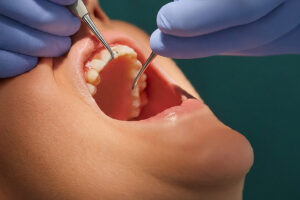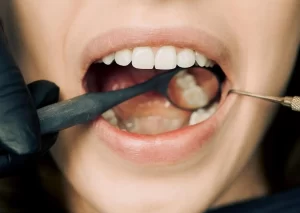Can Wisdom Teeth Grow Back?

As a dentist, I’ve encountered numerous questions and concerns regarding wisdom teeth, the third molars that emerge in our late teens or early twenties.
One of the most fascinating inquiries I come across is whether wisdom teeth can grow back after they’ve been removed.
Drawing from years of dental practice and scientific research, we’ll separate fact from fiction and provide a comprehensive overview of what patients can realistically expect when it comes to wisdom teeth.
Table of Contents
Can wisdom teeth grow back after they’ve been removed?
No, wisdom teeth cannot grow back after they have been removed. Human beings are born with a set number of teeth, including their wisdom teeth, which are also known as third molars.
Each person typically has up to four wisdom teeth, with one located in each corner of the mouth. These are the last teeth to emerge, usually appearing in late adolescence or early adulthood.
Once a tooth is removed, it does not regenerate or grow back.
This is because human teeth, including wisdom teeth, do not have the capability to regenerate. The ability to regrow teeth exists in some species, but not in humans.
Our teeth are formed during early development, and once the adult teeth, including the wisdom teeth, have come in and any of them are removed, they are gone for good.
Still, there can be cases where it seems like a wisdom tooth has “grown back” after removal. This rare occurrence can be attributed to a few possibilities:
Supernumerary Teeth
In some rare instances, individuals may have extra teeth beyond the usual 32 in adults, including more than four wisdom teeth. If an extra wisdom tooth is not detected during initial examinations and extractions, it might appear later, giving the impression that a wisdom tooth has grown back.
Incomplete Removal
On very rare occasions, a piece of the wisdom tooth root may not be completely removed during extraction. If this fragment remains viable, it might give the impression of regrowth, although this is not a new tooth growing but rather the body responding to the leftover tooth fragment.
Misdiagnosis
Sometimes, what is believed to be a regrown wisdom tooth might actually be the emergence of a previously impacted wisdom tooth that was not visible on x-rays or had not yet emerged at the time of the initial extractions.
In summary, once a wisdom tooth is fully removed, it cannot grow back. Any appearance of regrowth is likely due to other dental phenomena that should be evaluated by a dental professional.
What is Hyperdontia
Hyperdontia is a dental condition characterized by having an excessive number of teeth. These extra teeth, known as supernumerary teeth, can appear in any area of the dental arches and can affect both the primary (baby) and permanent (adult) teeth.
Hyperdontia can occur as a single isolated condition or may be associated with certain syndromes or genetic conditions.
Characteristics of Hyperdontia
- Location: Supernumerary teeth can appear in any part of the mouth but are most commonly found in the upper front teeth area, known as the maxillary incisors. They can also occur in the molars area.
- Types: There are several types of supernumerary teeth, including mesiodens (which occur near the upper front teeth), paramolars (next to the molars), and distomolars (located in the back of the mouth, behind the last molars).
- Symptoms: In many cases, hyperdontia does not cause any immediate symptoms. It can still lead to dental issues such as crowding, delayed eruption of permanent teeth, misalignment of teeth, and sometimes cyst formation.
- Diagnosis: Hyperdontia is typically diagnosed through dental X-rays, which can reveal the presence of extra teeth beneath the gums even before they erupt.
Causes of Hyperdontia
The exact cause of hyperdontia is not fully understood, but it is believed to be linked to a combination of genetic and environmental factors.
It can occur as a standalone condition or be associated with certain genetic syndromes, such as Gardner’s syndrome, Cleidocranial dysplasia, and Ehlers-Danlos syndrome, among others.
Treatment for Hyperdontia
Treatment for hyperdontia depends on the number and location of the supernumerary teeth, as well as the potential or actual impact on the surrounding teeth and overall dental health.
Options may include:
- Monitoring: If the supernumerary teeth are not causing any problems, a dentist may choose to monitor them over time.
- Extraction: Often, the extra teeth are extracted to prevent or resolve crowding, alignment issues, or damage to adjacent teeth.
- Orthodontic treatment: In cases where hyperdontia has led to misalignment or crowding, orthodontic treatment may be necessary to correct the dental arch and improve the bite.
Why Are Most Wisdom Teeth Pulled?
Most wisdom teeth are pulled due to a combination of factors related to their late emergence in the mouth and the limited space available for them to grow properly.
This often leads to complications that can affect oral health and the alignment of other teeth.
Here are the primary reasons why wisdom teeth are commonly extracted:
- Impaction: Wisdom teeth are prone to becoming impacted, meaning they cannot fully emerge through the gums. This can happen because there isn’t enough room in the jaw or because the teeth are misaligned. Impacted wisdom teeth can lead to pain, swelling, and infection.
- Crowding: The human jaw has evolved to be smaller over time, leaving less room for wisdom teeth. When these teeth try to emerge, they can push against other teeth, causing crowding and misalignment. This crowding can undo years of orthodontic work or make it difficult to clean teeth properly, leading to decay.
- Difficulty cleaning: Wisdom teeth are located at the back of the mouth, making them hard to reach with a toothbrush and floss. This difficulty in maintaining proper hygiene can result in tooth decay, gum disease, and the development of cysts or tumors around the impacted teeth.
- Infection: Partially erupted wisdom teeth create openings around the teeth that can become breeding grounds for bacteria. This can lead to an infection known as pericoronitis, characterized by painful, swollen gum tissue, bad breath, and potentially more serious complications.
- Cysts and tumors: The sac surrounding an impacted wisdom tooth can fill with fluid, forming a cyst that can damage the jawbone, teeth, and nerves. In rare cases, tumors (usually benign) can develop in this area, requiring more extensive surgical procedures.
- Orthodontic reasons: To prevent the potential for crowding and misalignment of teeth, especially after orthodontic treatment, dentists and orthodontists may recommend the removal of wisdom teeth.
FAQ on Can Wisdom Teeth Grow Back?
How do you know if your wisdom teeth are growing back?
Wisdom teeth cannot grow back once they have been removed. If you feel pain or notice swelling in the area where a wisdom tooth was extracted, it could be due to other issues such as infection, gum disease, or the emergence of a previously unnoticed supernumerary tooth. Consult a dentist for an accurate diagnosis.
Can teeth regrow after extraction?
No, teeth cannot regrow after extraction. Once an adult tooth is removed, it does not regenerate. The human body does not have the capability to produce new teeth to replace the ones that have been extracted.
Can wisdom teeth grow in and out?
No, wisdom teeth do not grow in and out. Once they emerge through the gums, they do not retract or re-emerge. However, their growth can be intermittent, meaning they might partially emerge and then stop growing for a time, which might give the impression of them moving in and out.
Why experts now say not to remove your wisdom teeth?
Experts now advocate a more conservative approach to wisdom teeth removal, suggesting not to remove them unless they cause problems. This shift is due to several reasons:
– Risk of complications: Wisdom teeth extraction can lead to complications such as infection, nerve damage, and dry socket. The risks associated with surgery are deemed unnecessary if the teeth are not causing issues.
– Lack of evidence: Research has shown that prophylactic removal of wisdom teeth does not significantly reduce the risk of crowding in the front teeth, challenging a common justification for the procedure.
– Natural function: If wisdom teeth are healthy, fully erupted, and properly aligned, they can function like any other teeth and contribute to the mouth’s overall health.
– Cost and recovery: The procedure can be costly and requires a recovery period, during which patients might experience discomfort and swelling.
Is 30 too old to have wisdom teeth removed?
No, 30 is not too old to have wisdom teeth removed. Adults of any age can undergo wisdom teeth extraction if needed. The decision is based on the teeth’s impact on oral health rather than the patient’s age.
Is wisdom teeth removal still recommended?
Wisdom teeth removal is recommended on a case-by-case basis, focusing on the presence of problems like pain, impaction, infection, cysts, or damage to adjacent teeth. The trend is towards a more conservative approach, with experts advising against prophylactic removal if the teeth are healthy, fully erupted, and not causing issues.
What is the alternative to wisdom teeth removal?
The alternative to wisdom teeth removal is monitoring and managing them conservatively, which includes regular dental check-ups, X-rays to assess their growth and impact, and maintaining good oral hygiene to prevent infection and decay. If issues arise, treatments such as antibiotics for infection or minor surgical procedures to address gum issues may be considered before opting for extraction.
Why are wisdom teeth not useful?
Wisdom teeth are often considered not useful because modern human diets are softer and cooking methods have evolved, reducing the need for these extra molars. On top of that, many people’s jaws are too small to accommodate them without causing crowding, misalignment, or impaction, leading to dental health issues.
Why are wisdom teeth so problematic?
Wisdom teeth are problematic due to evolutionary changes in human jaw size, leading to insufficient space for them to properly emerge. This can result in impaction, crowding, infection, and difficulty in cleaning, which may require their removal to prevent or address oral health issues.
Fact Checked
Our dedicated team rigorously evaluates every article and guide to ensure the information is factual, up-to-date, and free of bias.
Updated Regularly
We update our articles and reviews regularly to ensure you have access to the latest data in the dental industry.
The content on Dental3DU’s blog is intended for educational purposes only. This information should not be relied upon as professional medical counsel. Be sure to always consult with your dentist about the dangers and benefits of any medication, treatment or procedure.







